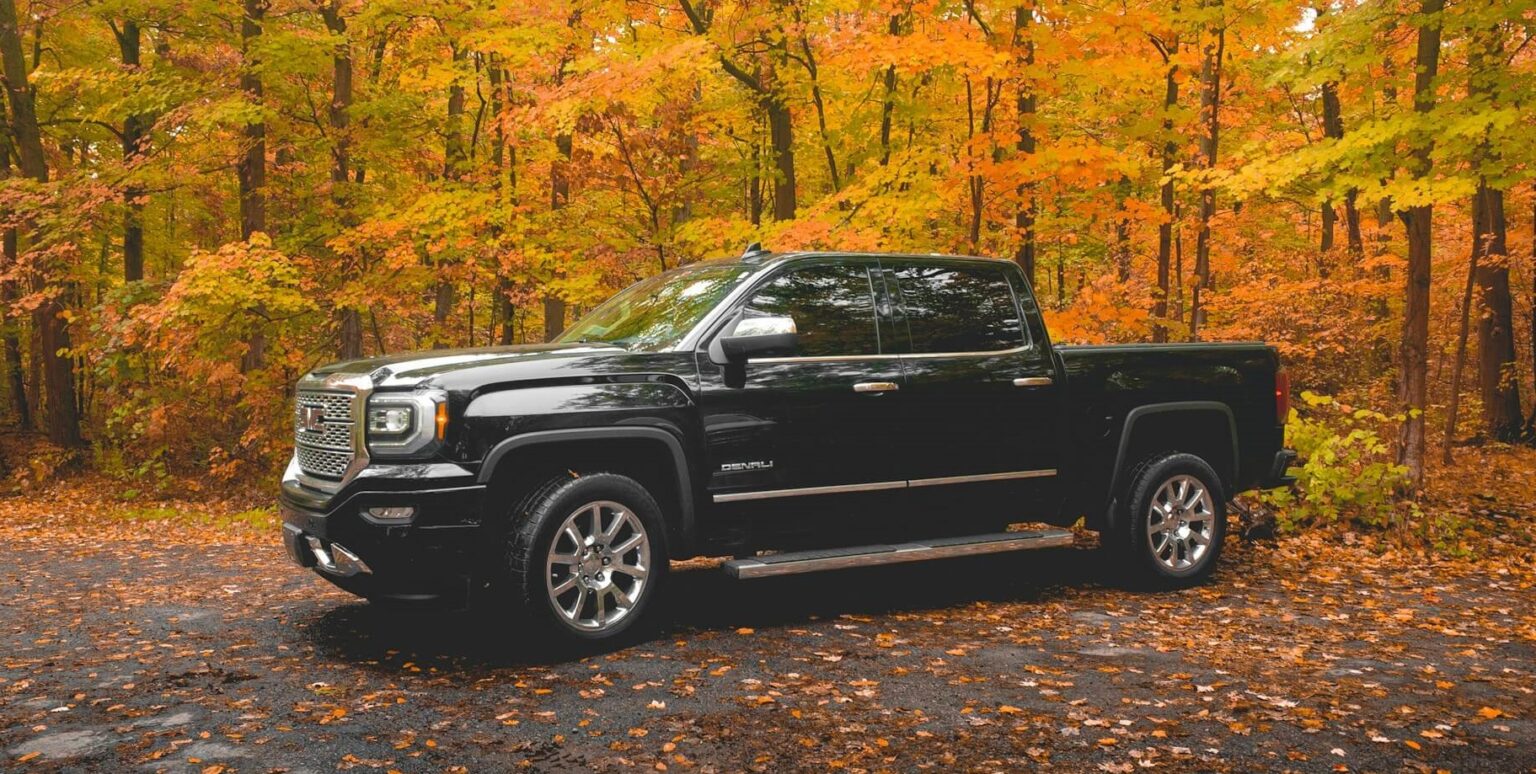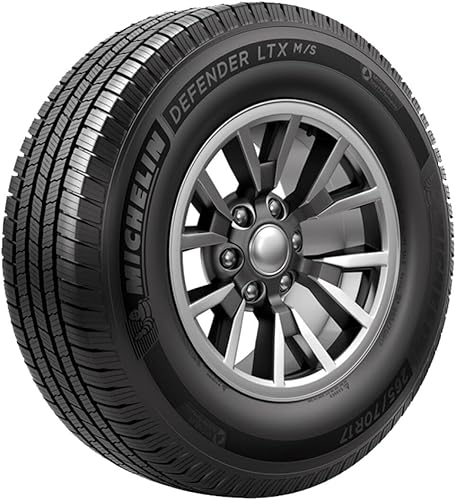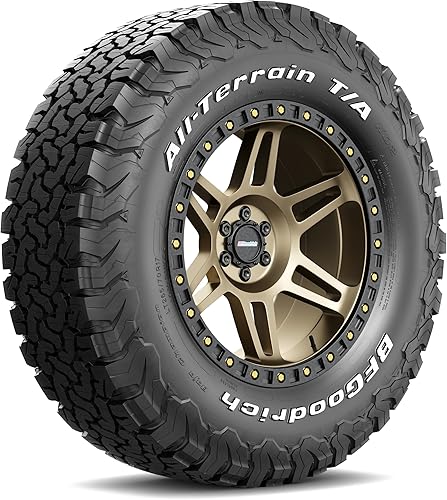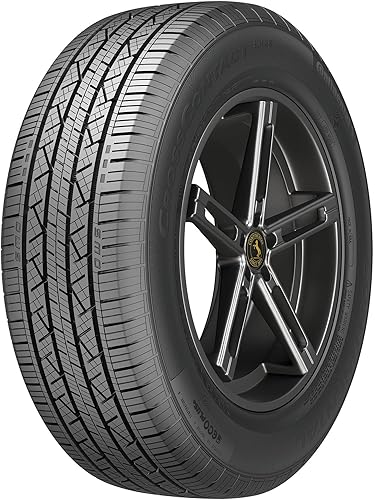If you’re gearing up to give your GMC Sierra 1500 the right shoes for whatever the road (or off-road) throws at you, you’re spot on by looking at the best five tires for it. The truck’s size, weight, and purpose demand a tire that can handle towing, hauling, highway miles and possibly rough terrain—without compromising ride comfort or fuel economy. In this guide, we’ve narrowed the field to the top five tire options tailored for the Sierra 1500, and our top pick is the MICHELIN Defender LTX M/S All-Season Radial Tire – a tire noted for its excellent all-season grip, quiet highway manner and long tread life, making it a smart match for your truck’s versatility and expectations.
Best 5 Tires for GMC Sierra 1500
01. MICHELIN Defender LTX M/S All-Season Radial Tire
The MICHELIN Defender LTX M/S All-Season Radial Tire has earned a solid name among pickup and SUV owners who deal with both heavy loads and unpredictable road conditions. Built using Michelin’s Evertread compound, it grips the road with a certain quiet confidence, even when the weather flips between rain, heat, and cold. The tire handles long highway drives with surprising smoothness, and it’s known for lasting longer than many other all-season truck tires in its class. Ideal for vehicles like the GMC Sierra, Ford F-150, or Toyota Highlander, it’s made to take on towing, hauling, and everyday use without wearing down too quickly.
✅ Pros:
- Outstanding tread life thanks to Michelin’s Evertread technology
- Strong traction on both wet and dry pavement
- Comfortable and low road noise for highway driving
- Great for heavy-duty trucks, SUVs, and crossovers
❌ Cons:
- Slightly higher price than other all-season options
- Not the best performer in deep snow or extreme off-road use
For anyone who values durability, fuel efficiency, and a balanced driving feel, the Defender LTX M/S is a dependable choice that just keeps rolling—mile after mile.
02. Cooper Discoverer S/T Maxx All-Season LT265/75R16 123/120Q Tire
The Cooper Discoverer S/T Maxx All-Season LT265/75R16 123/120Q Tire is built for those who spend more time on uneven dirt and rocky trails than smooth city roads. Its 3-ply Armor-Tek3 construction adds extra strength against punctures and sidewall damage — something truck and SUV owners really need when hauling heavy gear or towing on tough surfaces. This tire blends durability with traction, working well in wet, dry, and off-road conditions. You can almost feel the grit in its tread design, with deep grooves that claw through mud and gravel while still keeping highway noise under control.
✅ Pros:
- Excellent traction on mud, gravel, and rocky terrains
- Strong 3-ply Armor-Tek3 construction resists punctures
- Performs well for light trucks, SUVs, and 4×4 applications
- Handles towing and heavy loads without losing stability
❌ Cons:
- A bit noisier on highways compared to standard all-season tires
- Slightly heavier, which may impact fuel efficiency
If you drive a Ford F-150, Chevy Silverado, GMC Sierra 1500, Ram 2500, or similar heavy-duty pickup, this tire fits right into your off-road lifestyle. Its rugged tread pattern and hybrid compound make it a dependable choice for both work and weekend trips, proving that Cooper Tires still knows how to build something that’s tough, trustworthy, and long-lasting.
03. BFGoodrich All-Terrain T/A KO2
The BFGoodrich All-Terrain T/A KO2 is one of those rugged tires that feels like it was born for both asphalt and wild dirt tracks. Built for trucks, SUVs, and off-road rigs, it packs serious grip whether you’re rolling through rain, gravel, or snow. The thick tread blocks with stone ejectors keep it steady on rocky paths, while the sidewalls add that extra bite when you need traction in loose terrain. On highways, it doesn’t whine too much either — surprisingly smooth for something this aggressive. Perfect fit for vehicles like the Toyota Tacoma, Jeep Wrangler, GMC Sierra, or Ford F-150 if you want durability and toughness without switching tires every season.
✅ Pros:
- Strong sidewall design prevents cuts and punctures off-road
- Long tread life and even wear, even under heavy loads
- Performs well in snow and mud with 3PMSF certification
- Great traction for both off-road adventures and city driving
❌ Cons:
- A bit noisy at higher speeds compared to highway tires
- Heavier construction can affect fuel efficiency slightly
- Price sits on the higher side, but it’s justified for the durability
This tire ranks high among all-terrain enthusiasts and is frequently chosen by overlanders and off-road racers who prioritize traction, durability, and stability on mixed terrain.
04. Yokohama Geolandar AT G015 205/70R15 96H Tire
The Yokohama Geolandar AT G015 205/70R15 96H Tire is a rugged all-terrain performer built for SUVs, crossovers, and light trucks that face a mix of city roads and unpredictable backroads. It grips confidently whether you’re driving on slick pavement after rain or dry dusty trails that test your patience. The Enduro compound adds life to the tread, giving it strength against wear and tear, while the triple 3D sipes keep the blocks stiff for consistent traction. It’s not the loudest tire, which surprises people for an all-terrain set, but you’ll still hear a mild hum when pushing above 70 mph. Drivers who use their Toyota RAV4, Jeep Wrangler, or GMC Sierra 1500 for weekend trips off the asphalt tend to praise its even wear and cornering grip.
✅ Pros:
- Excellent traction on wet, snowy, and off-road surfaces
- Long tread life thanks to Yokohama’s Enduro compound
- Quiet for an A/T tire and holds stability on highways
- Sidewall protection for rock and debris resistance
❌ Cons:
- Slight drop in fuel efficiency due to aggressive tread pattern
- Can feel firm over smaller bumps or uneven asphalt
This Geolandar AT G015 manages that tricky balance between durability and comfort, making it one of the more versatile all-terrain tires in its size segment. Perfect for drivers who bounce between city commutes and muddy weekend drives, its overall reliability makes it a worthy upgrade for vehicles like the Subaru Forester, Honda CR-V, or Ford Escape looking for something tougher without losing road manners.
05. Continental CROSS CONTACT LX25 All- Season Radial Tire
The Continental CROSS CONTACT LX25 All-Season Radial Tire is one of those solid picks that quietly impresses you the more you drive. Built for SUVs and crossovers, this tire stands out for its wet traction stability, smooth ride comfort, and long tread life. The EcoPlus Technology improves fuel efficiency and reduces rolling resistance, making it a good fit for drivers who clock a lot of highway miles. Even during heavy rain or mild snow, the tire grips predictably without that uneasy slip feeling. Continental really leaned into balancing comfort and durability on this one.
✅ Pros:
- Excellent wet and dry traction performance
- Long-lasting tread with low road noise
- EcoPlus Technology boosts fuel efficiency
- Comfortable and stable ride on highways
❌ Cons:
- Not ideal for deep snow or extreme winter conditions
- Slightly higher price compared to budget all-season tires
If you’re running a Toyota RAV4, Honda CR-V, GMC Sierra 1500 or Ford Escape, this tire blends comfort, safety, and efficiency in a way that feels well-engineered but not overhyped. It’s a practical choice for anyone who values predictable handling and a quieter ride throughout the seasons.
How to Choose the Best Tires for GMC Sierra 1500
Sometimes it feels like the whole business of buying tires has turned into some sort of puzzle, doesn’t it? You stand there, looking at rows of rubber circles, all claiming to be “perfect for your truck.” But the truth is, what works for one GMC Sierra 1500 driver might feel wrong for another. Maybe you drive through wet backroads in rural Texas. Maybe you haul tools every morning before sunrise. Maybe you just like how the truck looks sitting still in the driveway. Tires affect all of it — ride comfort, mileage, traction, and even that feeling when you grip the wheel over gravel.
Understanding What Your GMC Sierra 1500 Really Needs
The Sierra 1500 is a strong machine. It can tow over 13,000 pounds if you push it right, which means tires aren’t just about looks — they carry serious responsibility. You can’t slap on any random set of all-season tires and expect the truck to behave. It’s not a sedan. Its weight, torque, and suspension geometry demand something tougher, something with a reinforced carcass.
Now, most Sierra 1500 trims — like the AT4 or Denali — come with tire sizes ranging roughly between 265/65R18 to 275/60R20, depending on how it left the factory. And those numbers matter. The “R” means radial (which almost everything is now), but it’s the load index and speed rating that tell you how well that tire will handle the muscle of the truck. Many people ignore that. They look at the brand first. Don’t do that.
Sometimes you might hear a guy at a tire shop swear by Michelin Defender LTX M/S, and yeah, it’s good — quiet on highways, long tread life — but if you go off-road once a week, those sidewalls will look chewed up fast. You need to balance priorities. Highway comfort? Or dirt-road confidence? The Sierra doesn’t like indecision.
The Battle Between All-Terrain and All-Season
Here’s where most people start overthinking. They read too much online. “All-terrain tires can handle anything.” Sure, they can handle it, but that doesn’t mean they’re happy doing it. All-terrains (like BFGoodrich KO2 or Goodyear Wrangler DuraTrac) come with aggressive tread blocks that bite well on loose dirt and snow. But they can get noisy — the kind of hum you start to notice after long drives.
All-seasons, on the other hand, ride like butter. Quiet, smooth, predictable. But they hate mud and can slip when things get slushy. If you’re mostly driving on highways, something like Continental TerrainContact H/T or Michelin LTX Trail might be perfect. They balance comfort with light off-road capability. It’s that middle ground that suits suburban or mixed-use Sierra owners.
Some truck enthusiasts rotate two sets — one for summer, one for winter — just to avoid compromise. Expensive, yes. But it works if you care about performance.
Tread Patterns, Rubber Compounds, and Other Nerdy Stuff
Ever notice how some tires have small zigzag sipes while others look like they could climb a mountain? Those grooves are designed to channel water away or dig into snow. The Sierra’s weight distribution (especially when towing) benefits from tires with deeper tread voids in the rear and multi-directional siping in front.
As for compounds, softer rubber gives better grip but wears faster. Harder rubber lasts longer but can lose traction on wet roads. Data from tire wear studies suggests that the average lifespan of a light-truck tire ranges between 45,000 to 70,000 miles, depending on use and driving temperature. For trucks that spend half their time hauling, the lower number is more realistic.
If you ever feel your Sierra pulling slightly to one side after replacing tires, don’t panic immediately. It’s often because new tread depth reacts differently to old suspension angles. Realignment helps. Most people skip that step, thinking the shop did it automatically — they rarely do.
Load Ratings, Ply Counts, and Weight
This part sounds boring, but it’s what keeps you safe. Load ratings tell you how much weight a tire can carry at maximum air pressure. The Sierra 1500, especially models with heavy towing packages, benefits from Load Range E tires, meaning they have 10-ply construction. Overkill for some, yes, but it handles towing and gravel without bulging.
If you don’t haul much, Load Range C or D tires are enough and will give a smoother ride. But beware: under-inflated E-rated tires can ride rougher and wear out faster if you don’t keep them at the correct PSI. Always check the door sticker, not just the sidewall numbers. Manufacturers calibrate suspension feel based on factory recommendations, and even a 5 PSI drop can change fuel economy by 1–2%. Small thing, big difference.
Real-World Stuff
Ever driven down I-40 at 70 mph and felt like your truck was humming a tune? That’s tire resonance. Heavier tread patterns tend to sing, especially after 15,000 miles when the wear becomes uneven. The Sierra’s cabin is quiet enough that you’ll notice it.
If you care about gas mileage, lighter rolling resistance matters. Switching from mud-terrains to highway tires can improve your MPG by up to 1.5–2 miles per gallon on long drives. Doesn’t sound like much, but over a year, it adds up.
Handling is another tricky thing. Some tires look tough but flex too much at higher speeds, especially with bigger sidewalls. A 65 aspect ratio gives you a comfortable cushion but might feel floaty in turns. A 55 or 60 handles tighter but transmits more road feedback. That trade-off becomes personal preference — no “best” choice here.
Weather and Climate
If you live in Arizona or Texas, the heat alone eats rubber. Softer compounds degrade faster, especially on blacktop that can reach 150°F. Up north, snow-rated tires with the Three-Peak Mountain Snowflake (3PMSF) symbol matter more than brand loyalty.
A buddy of mine in Minnesota swears his Sierra only feels “right” with Nokian Hakkapeliitta LT3 in winter. But try those same tires in Florida heat, and they’ll melt into goo. So yes, your ZIP code dictates your best choice more than anything else.
Wrapping Up
So, how to choose the best tires for your GMC Sierra 1500? It’s not a simple checklist. It’s a mix of driving style, geography, payload, and personal quirks. You figure it out the same way you get used to the truck itself — through time. You might start with all-seasons, move to all-terrains, and one day realize you value silence over traction. Or maybe the other way around.
The best tire isn’t the one everyone recommends online. It’s the one that feels right on your steering wheel, the one that grips when you push it and hums softly when you don’t. Tires, oddly enough, are like personalities — they reveal themselves slowly.
And when you find that set that fits your Sierra just right, you’ll know. You won’t even need to think about it anymore.






